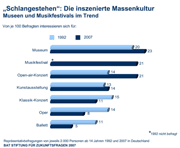"Queuing": the staged mass culture.
Museums, music festivals and open-air concerts in vogue
"In the future, people will queue in front of concert ticket offices, museums and art exhibitions like the post-war generation queued in front of grocery shops": This early prediction of the future by the BAT Leisure Research Institute in 1992 has now - fifteen years later - become reality in Germany. Since the end of May, up to 5,000 visitors have been queuing in front of the Neue Nationalgalerie in Berlin every day. And while the number of people interested in traditional events ranging from opera (1992: 14% - 2007: 8%) to ballet (1992: 14% - 2007: 5%) has halved, the focus of interest since 1992 has increasingly shifted to special events with an extraordinary character. This is the result of a recent representative survey in which British American Tobacco's FOUNDATION FOR FUTURE QUESTIONS asked 2,000 people aged 14 and over about their cultural interests and compared them with the survey results from fifteen years ago.
"More and more cities and regions are starting to create their own cultural summer, a kind of fifth season for city tourists and holidaymakers at home," says Prof Dr Horst W. Opaschowski, the Foundation's Scientific Director. "Exclusive special exhibitions in museums and galleries turn a visit into a social event. A 'must' for many. 'People' just go there". The cultural scene is becoming an event culture that the media are already reporting on before the events have even taken place.
The cultural landscape is becoming a place of experience for a broad public. The mass tourism onslaught continues. High culture takes on the characteristics of mass culture. Compared to the population as a whole, the younger generation in particular is migrating en masse to cultural events with an event character. These include above all music festivals (38% - rest of the population: 21%) and open-air concerts (43% - total population: 21%), while the 55-plus generation still prefers to go to the opera (13%) than to music festivals (11%) - even if the trend in opera attendance is declining (1992: 16% - 2007: 13%).
Professor Opaschowski: "Culture is taking on a new quality as a culture of events and entertainment. Programmes that neglect the experiential value, do not provide anything to talk about and do not trigger any discussions will have a difficult time. Experience culture pays off and turns subsidies into investments in the long term. The idea of culture as a 'breadless' art will soon be a thing of the past."
The winners of the cultural scene: museums as trendsetters
Museums in particular have been very successful in attracting visitors and sponsors in recent years. They are regarded as the winners of the cultural scene: almost one in four German citizens (1992: 20% - 2007: 23%) is an interested visitor. Together with other exhibition centres, museums currently record around 100 million visits per year. Instead of just preserving the museum experience, museums are constantly making their programmes more attractive to a broader section of the population. This is achieved with events such as the "Long Night of Museums" or the MoMA exhibition in Berlin. "Museums no longer just want to be guardians of tradition," says Julia Rombach, research associate at the BAT Foundation and author of the book "Traditionshüter oder Trendsetter? On the future of museums" (Lit Verlag). "A new generation of museums is emerging that is setting trends for the entire cultural sector. Professional media and public relations work, increasing visitor-orientation and new interactive forms of communication are making museums ever more attractive. Today's museum visitors don't want to be instructed, they want to be intelligently entertained."
Communication-enhancing and entertaining offers make the museum visit varied and introduce visitors to the content in a pleasant way. Critics see the danger of mass culture and the popularisation of museums reducing and simplifying the content. But in order to fulfil their social function, public museums in particular need high visitor numbers. Rombach: "Concepts focussed on mass and entertainment can never replace continuous cultural work. But if they succeed in attracting attention to culture and cultural education and arousing people's interest in culture, then mass culture also fulfils its social mission."
Despite many innovations, the museum landscape is still a long way from the cultural policy claim of "culture for all": among those interested in museums, the higher educated dominate by a wide margin (university graduates: 40% - total population: 23%). Education still makes culture. Even price reductions or free admission cannot compensate for the necessary lack of education. The museum audience has remained a high school graduate audience.
The book
JULIA ROMBACH: "Trendsetter or guardian of tradition? The future of museums."
is now available in bookshops: 224 pages - ISBN 978-3-8258-0669-9 (LIT Verlag Münster) - 2007 - 24,90 Euro



